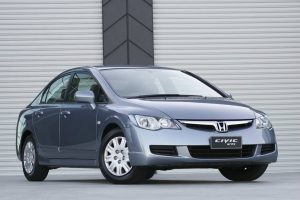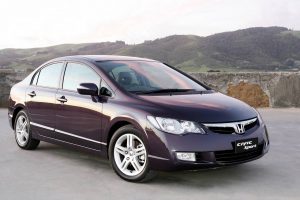Recalls: Honda FD1/FD2 Civic sedan
Overview
Manufacturers, or importers, issue recalls for defects or faults which have the potential to cause injury. Generally, manufacturers will inform the original buyers if their vehicle is subject to a recall and of the steps required to remedy the defect or fault. Please note that the recalls below (if any) are for Australian-delivered vehicles only. Furthermore, the number of recalls should not be taken as an indication of a model’s reliability or its safety more generally.
Recalls: Honda FD1/FD2 Civic sedan
2006 Honda FD2 Civic Sport: loss of power steering assistance
In October 2006, a recall was issued for Honda Civic Sport variants due to a condition in which the power steering system ceased to operate. If the Electronic Control Unit (ECU) received unstable voltage input from the motor angle detecting circuit, the fail-safe function of the power steering system may not operate. As a result, the EPS warning lamp would illuminate, the power steering assistance would cease and therefore require greater force for steering wheel operation (PRA 2006/8807).
Honda FD1/FD2 Civic sedan: engine may stall and not restart
In March 2007, a recall was issued for 2006 Honda Civic models due to potential contamination of the fuel pump relay coil which could fatigue and burnout due to repeated flexion by heat expansion and shrinkage. This could cause the engine to stall and not restart (PRA 2007/9129).
Honda FD1/FD2 Civic sedan: brake lamps may stop working
In September 2007, a recall was issued for Honda FD1/FD2 Civic sedan vehicles due to potential failure of the stop lamp switch, caused by an excessive quantity of grease having been applied to the telescopic steering column mechanism. As a result, the stop lamps may cease to function (PRA 2007/9504).
2006-11 model year Honda FD1/FD2 Civic: Takata airbag recall #1
In February 2016, a recall was issued for 2006 to 2011 model year Honda FD1 and FD2 Civic vehicles and this recall was updated in September 2017 with new information. In these vehicles, propellant wafers in some air bag inflators may absorb moisture – this could create excessive internal pressure when the airbag was deployed such that the body of the inflator could rupture upon deployment, increasing the risk of injury to the driver and other occupants. For the VINs of the recalled Honda FD1/FD2 Civic vehicles, please seePRA 2016/15198.
2006-11 Honda FD1/FD2 Civic: Takata airbag recall #2
In July 2016, a recall was issued for 2006 to 2011 model year Honda Civic vehicles and this recall was updated with new information in September 2017. In these vehicles, propellant wafers in the airbag inflators could absorb moisture over time, causing overly aggressive combustion if the airbag was deployed – this would create excessive internal pressure that could cause the airbag inflator housing to rupture and scatter metal fragments through the airbag cushion material. These scattered fragments could cause serious injury or fatality to vehicle occupants. For the VINs of the recalled Honda Civic vehicles, please see PRA 2016/15494.
2006-11 model year Honda FD1/FD2 Civic: Takata airbag recall #3
In October 2019, recall campaign 6EE was issued for 2006-11 model year Honda FD1/FD2 Civic vehicles. These vehicles had been fitted with a complete driver airbag assembly that was determined to contain an affected Takata airbag inflator. Takata driver airbags contained propellant wafers which could absorb moisture over time. In the event of airbag deployment, excessive pressure in the airbag inflator housing could cause it to rupture so that metal fragments could be projected through the airbag cushion into the vehicle’s cabin. These metal fragments posed a risk of serious injury and fatality. For the VINs of the recalled vehicles, please see PRA 2019/17660.
Search online for recalls by VIN
To see if a Honda vehicle has been recalled, you can conduct a search on the Honda Australia website using its VIN.
Problems and faults: Honda FD1/FD2 Civic
Overview
This section identifies potential problems, causes and fixes based on the experiences of owners and repairers, online sources and technical service bulletins. This information is provided solely for reference purposes and AustralianCar.Reviews recommends that only properly qualified persons carry out repairs or modifications. Furthermore, the number of items below should not be taken as an indicator of a model’s reliability or the frequency with which they may occur.
To report a problem or fault to the AustralianCar.Reviews team, please use the Contact Us form. Note that AustralianCar.Reviews does not offer advice on automotive problems or disputes; such enquiries will not receive a reply. For vehicles purchased from dealers after 1 January 2011, please see our Australian Consumer Law fact sheet.
Problems and faults: Honda FD1/FD2 Civic sedan
- Rattling noises from the front of the vehicle when going over bumps may be due to defective liquid-filled engine mounts; an improved replacement component was subsequently released.
- The rear tyres may wear prematurely due to the design of rear suspension; an upper control arm repair kit was introduced to remedy this problem.
- For models with automatic transmissions, the brakes could feel stiff when first starting in cold weather – this may be remedied by replacing the brake booster.
- If the battery is drained and the car is jump-started with the security system set, the engine will not start and the immobiliser light will blink.
- A faulty occupant position sensor in the front passenger seatback could cause the ‘SRS’ (airbag) light to stay on.
- The ‘check engine’ light may illuminate due to a malfunction of the air/fuel sensor – this sensor may get wet from moisture in the exhaust system, requiring it to be replaced.
- If water enters the position switch for the door lock, the remote central locking may not work.
- The windscreen wipers may not turn off when parked, especially in cold weather, due to problems with the windscreen wiper motor.
- The sun visors should be handled carefully as they were liable to break.




